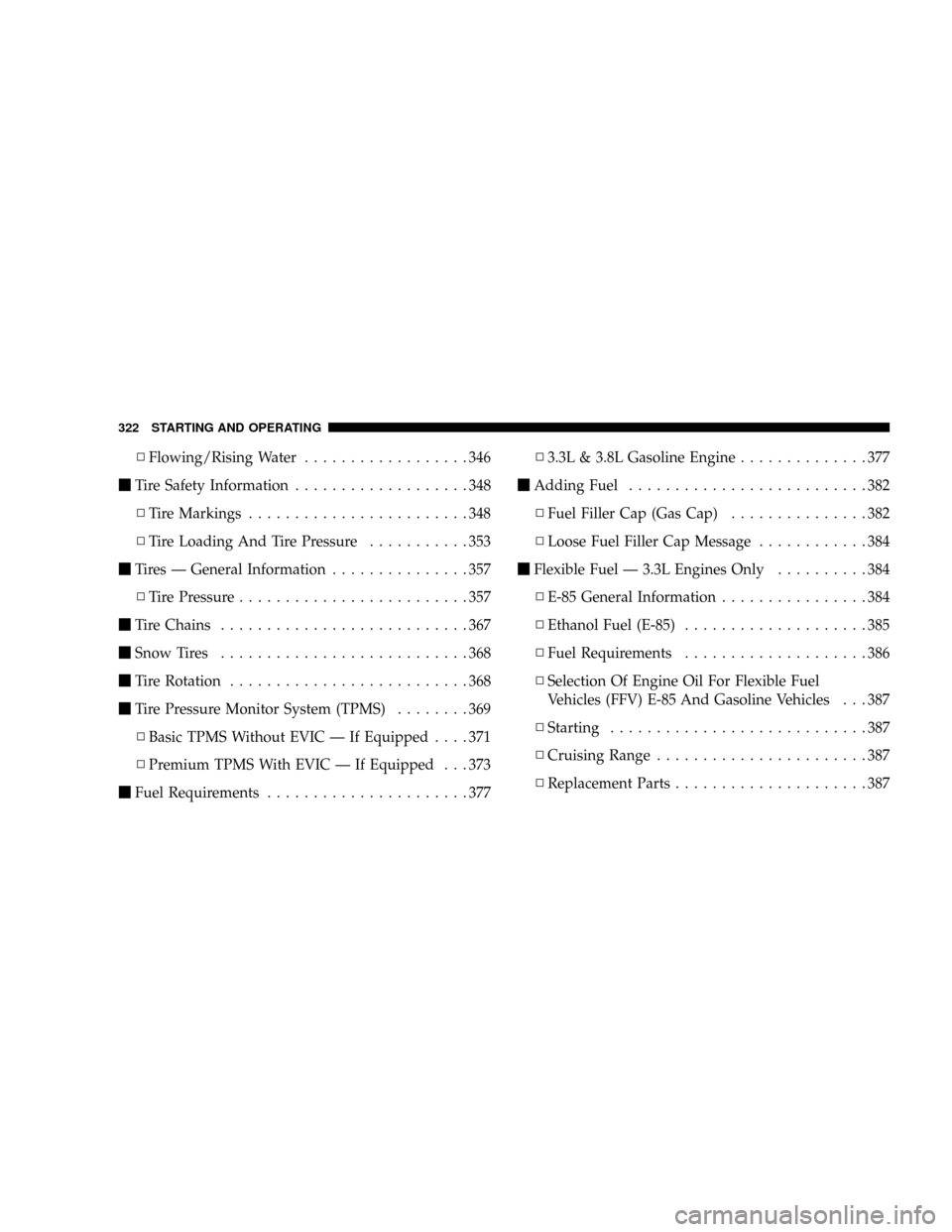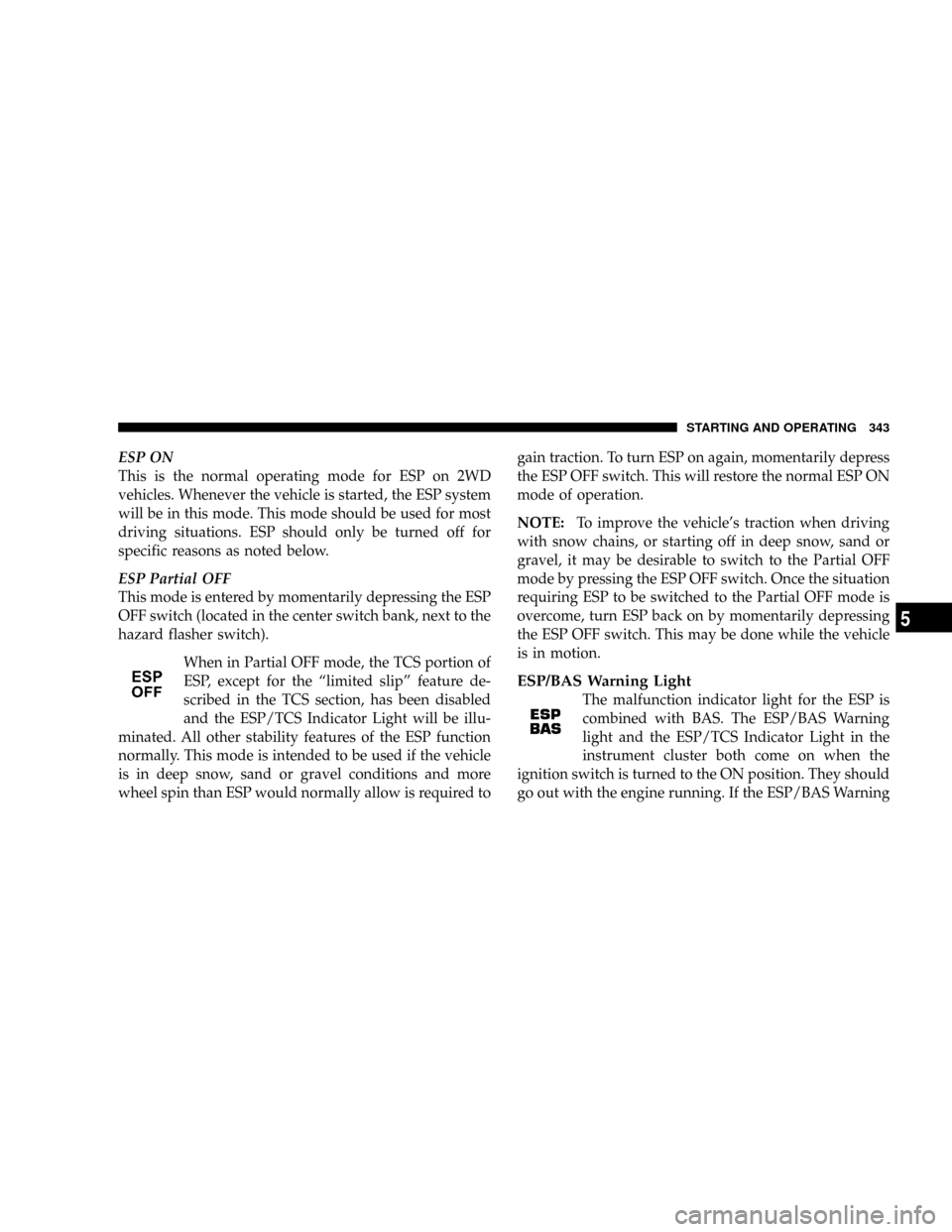2008 DODGE CARAVAN snow chains
[x] Cancel search: snow chainsPage 324 of 531

NFlowing/Rising Water..................346
mTire Safety Information...................348
NTire Markings........................348
NTire Loading And Tire Pressure...........353
mTires Ð General Information...............357
NTire Pressure.........................357
mTire Chains...........................367
mSnow Tires...........................368
mTire Rotation..........................368
mTire Pressure Monitor System (TPMS)........369
NBasic TPMS Without EVIC Ð If Equipped....371
NPremium TPMS With EVIC Ð If Equipped . . . 373
mFuel Requirements......................377N3.3L & 3.8L Gasoline Engine..............377
mAdding Fuel..........................382
NFuel Filler Cap (Gas Cap)...............382
NLoose Fuel Filler Cap Message............384
mFlexible Fuel Ð 3.3L Engines Only..........384
NE-85 General Information................384
NEthanol Fuel (E-85)....................385
NFuel Requirements....................386
NSelection Of Engine Oil For Flexible Fuel
Vehicles (FFV) E-85 And Gasoline Vehicles . . . 387
NStarting............................387
NCruising Range.......................387
NReplacement Parts.....................387
322 STARTING AND OPERATING
Page 345 of 531

ESP ON
This is the normal operating mode for ESP on 2WD
vehicles. Whenever the vehicle is started, the ESP system
will be in this mode. This mode should be used for most
driving situations. ESP should only be turned off for
specific reasons as noted below.
ESP Partial OFF
This mode is entered by momentarily depressing the ESP
OFF switch (located in the center switch bank, next to the
hazard flasher switch).
When in Partial OFF mode, the TCS portion of
ESP, except for the ªlimited slipº feature de-
scribed in the TCS section, has been disabled
and the ESP/TCS Indicator Light will be illu-
minated. All other stability features of the ESP function
normally. This mode is intended to be used if the vehicle
is in deep snow, sand or gravel conditions and more
wheel spin than ESP would normally allow is required togain traction. To turn ESP on again, momentarily depress
the ESP OFF switch. This will restore the normal ESP ON
mode of operation.
NOTE:To improve the vehicle's traction when driving
with snow chains, or starting off in deep snow, sand or
gravel, it may be desirable to switch to the Partial OFF
mode by pressing the ESP OFF switch. Once the situation
requiring ESP to be switched to the Partial OFF mode is
overcome, turn ESP back on by momentarily depressing
the ESP OFF switch. This may be done while the vehicle
is in motion.
ESP/BAS Warning Light
The malfunction indicator light for the ESP is
combined with BAS. The ESP/BAS Warning
light and the ESP/TCS Indicator Light in the
instrument cluster both come on when the
ignition switch is turned to the ON position. They should
go out with the engine running. If the ESP/BAS Warning
STARTING AND OPERATING 343
5
Page 370 of 531

Always use the lower suggested operating speed if both
the chain manufacturer and vehicle manufacture suggest
a maximum speed. This notice applies to all chain
traction devices, including link and cable (radial) chains.
SNOW TIRES
Some areas of the country require the use of snow tires
during Winter. Standard tires are of the all-season type
and satisfy this requirement as indicated by the M+S
designation on the tire sidewall.
If you need snow tires, select tires equivalent in size and
type to the original equipment tires. Use snow tires only
in sets of four; failure to do so may adversely affect the
safety and handling of your vehicle.
Snow tires generally have lower speed ratings than what
was originally equipped with your vehicle and should
not be operated at sustained speeds over 75 mph (120
km/h).
TIRE ROTATION
Tires on the front and rear axles of vehicles operate at
different loads and perform different steering, driving,
and braking functions. For these reasons, they wear at
unequal rates, and tend to develop irregular wear pat-
terns.
These effects can be reduced by timely rotation of tires.
The benefits of rotation are especially worthwhile with
aggressive tread designs such as those on All-Season type
tires. Rotation will increase tread life, help to maintain
mud, snow, and wet traction levels, and contribute to a
smooth, quiet ride.
Follow the recommended tire rotation frequency for your
type of driving found in the ªMaintenance Schedulesº
section of this manual. More frequent rotation is permis-
sible if desired. The reasons for any rapid or unusual
wear should be corrected prior to rotation being per-
formed.
368 STARTING AND OPERATING
Page 374 of 531

The Basic TPMS consists of the following components:
²Receiver Module
²Four Wheel Sensors
²TPMS Telltale Warning Light
The TPMS Telltale Warning Light will illumi-
nate in the instrument cluster, and an audible
chime will be activated when one or more of
the four active road tire pressures are low.
Should this occur, you should stop as soon as possible,
check the inflation pressure of each tire on your vehicle,
and inflate each tire to the vehicle's recommended cold
tire pressure value (located on the placard on the
driver's-side B-Pillar). The system will automatically
update and the TPMS Warning Lamp will extinguish
once the updated tire pressures have been received.
NOTE:
The vehicle may need to be driven for up to 10
minutes above 15 mph (25 km/h) to receive this information.
The TPMS Warning Lamp will flash on and off for 75
seconds, and remain on sold when a system fault is
detected. The system fault will also sound a chime. If the
ignition key is cycled, this sequence will repeat, provid-
ing the system fault still exists. The TPMS Warning Lamp
will turn off when the fault condition no longer exists. A
system fault can occur with any of the following sce-
narios:
1. Jamming due to electronic devices or driving next to
facilities emitting the same radio frequencies as the TPMS
sensors.
2. Installing some form of aftermarket window tinting
that affects radio wave signals.
3. Accumulation of excessive snow and/or ice around
the wheels or wheel housings.
4. Using tire chains on the vehicle.
5. Using wheels/tires not equipped with TPMS sensors.
372 STARTING AND OPERATING
Page 378 of 531

will not be present, and a pressure value will be dis-
played instead of dashes. A system fault can occur by any
of the following scenarios:
1. Jamming due to electronic devices or driving next to
facilities emitting the same radio frequencies as the TPMS
sensors.
2. Installing some form of aftermarket window tinting
that affects radio wave signals.
3. Accumulation of excessive snow and/or ice around
the wheels or wheel housings.
4. Using tire chains on the vehicle.
5. Using wheels/tires not equipped with TPMS sensors.
NOTE:
1. The compact spare tire (if equipped) does not have a
TPMS. Therefore, the TPMS will not monitor the pressure
in the compact spare tire.2. If you install the compact spare tire in place of a road
tire that has a pressure below the low-pressure warning
limit, upon the next ignition key cycle, the TPMS Telltale
Warning Light will remain on, a chime will sound, and
the EVIC will still display a flashing pressure value in the
graphic display.
3. After driving the vehicle for up to 10 minutes above 15
mph (25 km/h), the TPMS Telltale Warning Light will
flash on and off for 75 seconds and then remain on solid.
In addition, the EVIC will display a9CHECK TPM
SYSTEM9message for three seconds and then display
dashes (- -) in place of the pressure value.
4. For each subsequent ignition key cycle, a chime will
sound, the TPMS Telltale Warning Light will flash on and
off for 75 seconds and then remain on solid, and the EVIC
will display a CHECK TPM SYSTEM message for three
seconds and then display dashes (- -) in place of the
pressure value.
376 STARTING AND OPERATING
Page 525 of 531

Service Engine Soon Light (Malfunction Indicator). . 232
Service Manuals........................ 504
Setting the Clock................254,269,281,285
Settings, Personal........................ 248
Shoulder Belts........................... 57
Signals, Turn...................166,227,483,484
Sliding Door............................ 41
Slippery Surfaces, Driving On............... 345
Snow Chains (Tire Chains)................. 367
Snow Tires............................ 368
Sound Systems (Radio).................280,283
Spare Tire.......................361,362,414
Spark Plugs............................ 445
Speed Control (Cruise Control).............. 179
Speedometer........................... 227
Starting............................... 324
Automatic Transmission................. 325
Cold Weather......................... 325
Engine Fails to Start.................... 326Remote.............................. 28
Starting and Operating.................... 324
Starting Procedures...................... 324
Steering
Column Controls...................... 166
Linkage............................. 453
Power...........................344,452
Shaft Seal............................ 453
Tilt Column.......................... 171
Steering Wheel Mounted Sound System Controls... 299
Storage............................208,481
Storage Bin............................ 208
Storage, Vehicle......................318,481
Storing Your Vehicle...................... 481
Stow8n Go (Fold in Floor) Seats............. 138
Sun Roof.............................. 192
Sunglasses Storage....................... 183
Sunroof Maintenance..................... 195
Supplemental Restraint System - Airbag........ 66
INDEX 523
10
Page 526 of 531

Synthetic Engine Oil...................... 444
System, Navigation...................... 283
System, Remote Starting.................... 28
Tachometer............................ 229
Temperature Control, Automatic (ATC)........ 309
Temperature Gauge, Engine Coolant........226,411
Tether Anchor, Child Restraint............... 86
Tilt Steering Column..................... 171
Tip Start............................... 13
Tire and Loading Information Placard......... 353
Tire Identification Number (TIN)............. 352
Tire Markings.......................... 348
Tire Safety Information.................... 348
Tires ............................94,357,505
Aging (Life of Tires).................... 364
Air Pressure.......................... 357
Alignment........................... 366
Chains.............................. 367Changing............................ 412
Compact Spare........................ 361
Flat Changing........................ 422
General Information.................... 357
High Speed.......................... 360
Inflation Pressures..................... 358
Jacking...........................412,415
Life of Tires.......................... 364
Load Capacity.....................353,354
Pressure Monitor System (TPMS)........... 369
Quality Grading....................... 505
Radial.............................. 361
Replacement......................... 365
Rotation............................. 368
Safety...........................348,357
Sizes............................... 350
Snow Tires........................... 368
Spare Tire........................... 414
Spinning............................ 363
524 INDEX